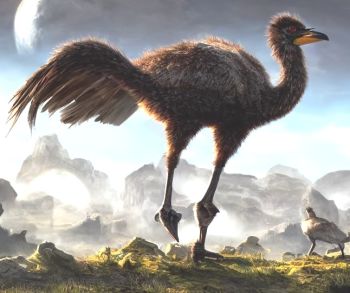Difference between revisions of "Emu"
Tao alexis (talk | contribs) |
Tao alexis (talk | contribs) |
||
| Line 22: | Line 22: | ||
[[File:Emu.jpg|left|350px|thumb]] | [[File:Emu.jpg|left|350px|thumb]] | ||
__TOC__ | __TOC__ | ||
| + | Emus fall prey to [[Megalania Lizard|megalania]], [Thylacine|thylacine]] and [[Dingo|dingos]], with the latter species often hunting emus in organized packs. Emu meat and eggs are highly valued by hunters. These birds are commonly captured through various methods, including spearing them at waterholes, ensnaring them in nets, luring them with mimicry of their calls or piquing their curiosity with a dangling ball of feathers and rags from a tree. Emu fat is harvested for its oil, their bones are crafted into knives and tools, their feathers are employed for decorative purposes and their tendons serve as valuable strings. | ||
| + | == Behaviour == | ||
| − | |||
| − | |||
Breeding takes place in November and December in the northern hemisphere, or May and June in the south. Fighting among females for a mate is common. The emu becomes very aggressive at this time towards outsiders. The female lays 5-7 eggs, which are cared for by the male, who does not abandon the eggs until they hatch, starving himself and growing more aggressive; over the eight-week incubation period, he will lose a third of his weight. The chicks, when born, weigh about a pound, and require seven months to become fully grown. | Breeding takes place in November and December in the northern hemisphere, or May and June in the south. Fighting among females for a mate is common. The emu becomes very aggressive at this time towards outsiders. The female lays 5-7 eggs, which are cared for by the male, who does not abandon the eggs until they hatch, starving himself and growing more aggressive; over the eight-week incubation period, he will lose a third of his weight. The chicks, when born, weigh about a pound, and require seven months to become fully grown. | ||
Revision as of 21:27, 2 November 2023
| Species | flightless bird |
| No. Appearing | 4–16 |
| Behaviour | herd |
| Range | desert, savanna |
| Size | 6 ft. 3 in. tall |
| Weight | 130 lbs. |
| Intelligence | 1 |
| Armour Class | 7 |
| Hit Dice | 1 |
| Action Points | 5 |
| Max. Stride | 17 |
| THAC0 | 20 |
| Hp/Die | d6 |
| Attack Forms | kick & peck |
| Damage | 1–8 & 1–4 |
| Special Attacks | back kick |
Emu are large flightless birds that breed along the coastlands of the Indian Oceant from Makran and Baluchistan to Australia. These birds are capable of covering vast distances and can endure weeks without nourishment. Their water consumption is infrequent, yet they seize the chance to drink substantial quantities when the opportunity occurs.
Contents
Emus fall prey to megalania, [Thylacine|thylacine]] and dingos, with the latter species often hunting emus in organized packs. Emu meat and eggs are highly valued by hunters. These birds are commonly captured through various methods, including spearing them at waterholes, ensnaring them in nets, luring them with mimicry of their calls or piquing their curiosity with a dangling ball of feathers and rags from a tree. Emu fat is harvested for its oil, their bones are crafted into knives and tools, their feathers are employed for decorative purposes and their tendons serve as valuable strings.
Behaviour
Breeding takes place in November and December in the northern hemisphere, or May and June in the south. Fighting among females for a mate is common. The emu becomes very aggressive at this time towards outsiders. The female lays 5-7 eggs, which are cared for by the male, who does not abandon the eggs until they hatch, starving himself and growing more aggressive; over the eight-week incubation period, he will lose a third of his weight. The chicks, when born, weigh about a pound, and require seven months to become fully grown.
When attacked, they will typically spend one round attacking with beak and hoof; they will then turn and back kick with one foot. The hooves of the emu are heavy and sharp, so that upon a hit the hoof will do 2-16 damage. The emu will then run, making no attempt to re-enter combat.
See Bestiary
